

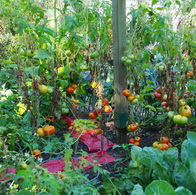
Ahh! The wonderful smell of bacon frying fills the kitchen. It’s mid August and there has finally been enough sun to produce the first ripe Tomatoes and we can have a Bacon and Tomato sandwich. Of course I just stand in the garden and eat the first couple of Tomatoes but then we ignore all the health warnings about bacon and make a few of our favourite summer sandwiches. About three weeks later than normal this year. Strangely many things are actually earlier. The Japanese Anemones are in full bloom and the autumn blooming Sedums are already fully coloured up. Mother Nature never promised to make sense. 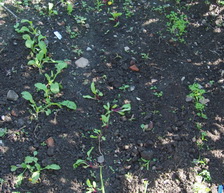 Some of the early vegetables have been removed from the garden and their space cleared of any natural vegetation that was trying to establish itself. Great fall vegetables are seeded here in the first weeks of August and already the Beets, Carrots, Kohl Rabi and Pak Choi have emerged from the soil and have had a thinning. Let no patch of soil go unused if we want to maximize the production from a small garden.
Some of the early vegetables have been removed from the garden and their space cleared of any natural vegetation that was trying to establish itself. Great fall vegetables are seeded here in the first weeks of August and already the Beets, Carrots, Kohl Rabi and Pak Choi have emerged from the soil and have had a thinning. Let no patch of soil go unused if we want to maximize the production from a small garden. 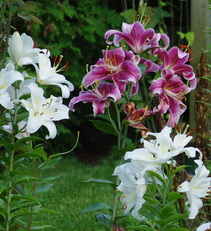 The majestic Oriental Lilies are now in full bloom as they finish up the Lily season in my garden. Over a few years they slowly get bigger but rarely multiply. The large blooms, from pure white to dark pink, are quite breathtaking and are a fitting finale to the Lily season. I keep busy cutting off the tops of all the finished Lilies to stop any seed pods from developing. We want all of that plant energy to go into rebuilding the bulbs for next year’s bloom. I have occasionally let seeds develop, collected it and tried to wait the three to four years it takes to grow a blooming sized plant. The process makes me realize that it is a good thing that I never realized my early ambitions to become a plant breeder. Apparently I lack the year over year patience that requires.
The majestic Oriental Lilies are now in full bloom as they finish up the Lily season in my garden. Over a few years they slowly get bigger but rarely multiply. The large blooms, from pure white to dark pink, are quite breathtaking and are a fitting finale to the Lily season. I keep busy cutting off the tops of all the finished Lilies to stop any seed pods from developing. We want all of that plant energy to go into rebuilding the bulbs for next year’s bloom. I have occasionally let seeds develop, collected it and tried to wait the three to four years it takes to grow a blooming sized plant. The process makes me realize that it is a good thing that I never realized my early ambitions to become a plant breeder. Apparently I lack the year over year patience that requires.  I have also had a couple of interesting day trips in the past week. Loblaws, a large Canadian grocery chain, is quite serious about their gardening products and becoming more so. They feature a range of vegetables in large pots during the spring planting season. They invited a group of garden writers to St. Catherines last week to the trial grounds of Stokes’ seeds. They had been trialing a number of new and different vegetables to see which ones they would include in their “Gigantico” program next year and they wanted our opinions on which were the best new varieties. We tasted, Tomatoes, Peppers, Cucumbers, Zucchini and for the truly brave, one Eggplant, (not known for its raw eating properties.) In the interests of full disclosure, they then treated us to a delightful lunch and a glass of the local vintage and then we discussed our opinions. As you might expect they were some wide ranges of opinion but a few of the varieties stood out as exceptional by almost everyone’s standards and we can expect to see them, in their stores next spring. They also ably addressed the concern about what might seem to be a relatively high retail price for these large vegetable plants. They are not just bigger, they are new and better, therefore having expensive seeds and higher production costs. In the real world of large retail, they need to pick a single price point that reflects their average cost. It is not logistically possible to sell some at $2.98, some at $3.49 and some at $3.97. Most of the writers present, myself included were impressed with the thoroughness of their approach and the actual interest in the quality of their product line. The lunch was also delightful and if you are ever travelling in Ontario’s wine region stop at “About Thyme” in Beamsville for a taste treat.
I have also had a couple of interesting day trips in the past week. Loblaws, a large Canadian grocery chain, is quite serious about their gardening products and becoming more so. They feature a range of vegetables in large pots during the spring planting season. They invited a group of garden writers to St. Catherines last week to the trial grounds of Stokes’ seeds. They had been trialing a number of new and different vegetables to see which ones they would include in their “Gigantico” program next year and they wanted our opinions on which were the best new varieties. We tasted, Tomatoes, Peppers, Cucumbers, Zucchini and for the truly brave, one Eggplant, (not known for its raw eating properties.) In the interests of full disclosure, they then treated us to a delightful lunch and a glass of the local vintage and then we discussed our opinions. As you might expect they were some wide ranges of opinion but a few of the varieties stood out as exceptional by almost everyone’s standards and we can expect to see them, in their stores next spring. They also ably addressed the concern about what might seem to be a relatively high retail price for these large vegetable plants. They are not just bigger, they are new and better, therefore having expensive seeds and higher production costs. In the real world of large retail, they need to pick a single price point that reflects their average cost. It is not logistically possible to sell some at $2.98, some at $3.49 and some at $3.97. Most of the writers present, myself included were impressed with the thoroughness of their approach and the actual interest in the quality of their product line. The lunch was also delightful and if you are ever travelling in Ontario’s wine region stop at “About Thyme” in Beamsville for a taste treat.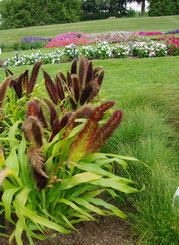 I was also at the trial grounds run, in two locations, by the University of Guelph and Landscape Ontario. There were a few vegetables but these are primarily trials of annual flowers and some perennials. The purpose of these trials is just to note the performance of a range of older and new varieties in our particular part of the world. This is part of the trials run by All America selections to ascertain which new varieties will be given their awards as outstanding new varieties each year. A very wide range of flowers were available to be seen and discussed but this being a public institution the lunch was lovely but not to the standard of the previous week. The most interesting portion of this day was a tour of the Turf Grass Research Institute and the work they are doing to deal with the ban on cosmetic pesticides in our province. That’s a story in itself and I will be reporting that to my readers in the near future.
I was also at the trial grounds run, in two locations, by the University of Guelph and Landscape Ontario. There were a few vegetables but these are primarily trials of annual flowers and some perennials. The purpose of these trials is just to note the performance of a range of older and new varieties in our particular part of the world. This is part of the trials run by All America selections to ascertain which new varieties will be given their awards as outstanding new varieties each year. A very wide range of flowers were available to be seen and discussed but this being a public institution the lunch was lovely but not to the standard of the previous week. The most interesting portion of this day was a tour of the Turf Grass Research Institute and the work they are doing to deal with the ban on cosmetic pesticides in our province. That’s a story in itself and I will be reporting that to my readers in the near future.Gardening-enjoyed.com has a new feature. You can now easily search my entire site for answers to your gardening mysteries. If that doesn’t get you what you need to know keep reading here. Questions My newsletter subscribers get to ask me questions. Just ‘reply’ to the email newsletter. It is always interesting to read the questions; mostly to see if I actually can answer them or if I have to wade into the textbooks to research the answers. If that happens then we all learn something. Barb Asks? HI Ken, I enjoy every issue of your newsletter. I am pleased that most things are thriving this year. I do have a couple of concerns: my corkscrew Hazel has very few leaves this year. Any ideas? Also, my Iris are being attacked by the borer again. Did the experiment you tried last year work? I even forget what it was you tried. Thank-you! Ken Answers! Barb, I have used parasitic nematodes to control the borer on my Iris plants for the last two years. The first year was very successful and this year a little less so but I think I was a bit late this year and the window of opportunity was closing fast. At this point all you can do is dig out the infected plant and kill the borer. The leafless Hazel is a bit more difficult without more information. Was it a new plant last year? We had very cloudy / rainy weather in my part of the world but many things received insufficient water. Despite the constant overcast the actual amount of water that reached the ground was quite limited. This resulted in a lot of plants developing shallow roots, that could not then go many days without more water. Stephanie Asks? I'm new to your newsletter and have a question about Lilacs. Last year I planted a Lilac bush in a spot in the yard that had never been planted on before. It was about 3 feet high, had a lot of leaves, seemed to be doing well and then we started noticing dried leaves here and there, then whole dead branches. A couple of branches were found on the ground too. At first i was thinking deer got at it but that wouldn’t have caused the leaves to brown. It got to a point where there were only two branches left and deadening leaves and i noticed a strange bug on the back of one of the leaves -- maybe a Japanese beetle? Does this mean i cannot grow lilac in my yard period? Thank you! Ken Answers! The brown dead leaves could be the result of insufficient water. New plants only have the roots that came in the pot with them and that small area has to be watered deeply on a regular basis. The branches actually drying out and breaking off is rather strange. Japanese Beetles are a terrible pest but if that was the problem the leaves would be being eaten and disappear rather than stay on the plant and turn brown. Dig it up; it’s not going to come back from the dead, and see if the roots were also dried out and brittle. Most nurseries guarantee their plants and you may get a replacement. Try again, I don’t see anything in your description that should actually prevent the growing of Lilacs, a very hardy and easy to grow plant. Just make sure to water any new plant thoroughly and regularly. 111 Trent St. W. Whitby ON L1N1L9 |
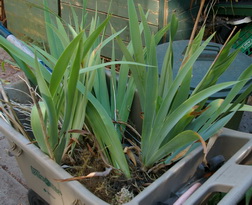 I realize that I am a bit slow at getting out this edition of “Dallying” but I am a gardener before I’m a writer and there has just been too many things happening in August. Several of my Iris have called me as I walked by and indicated that this was their year to be
I realize that I am a bit slow at getting out this edition of “Dallying” but I am a gardener before I’m a writer and there has just been too many things happening in August. Several of my Iris have called me as I walked by and indicated that this was their year to be 